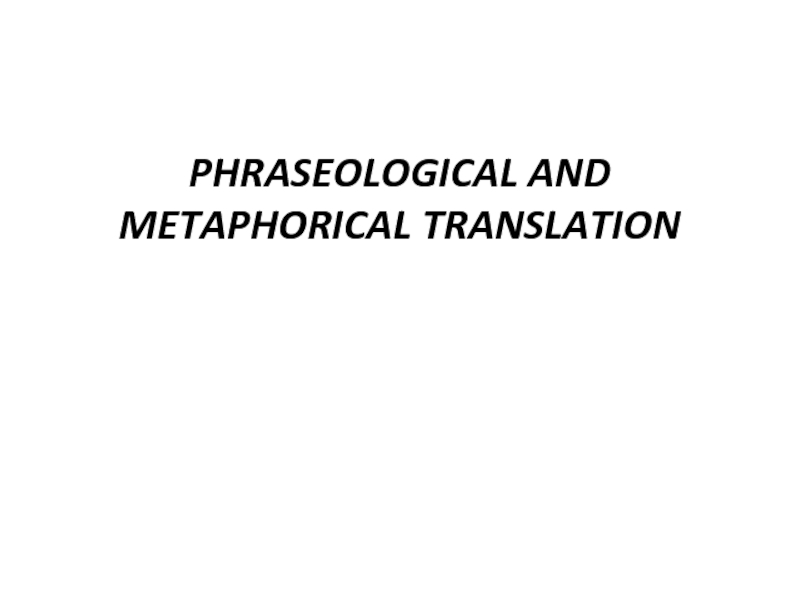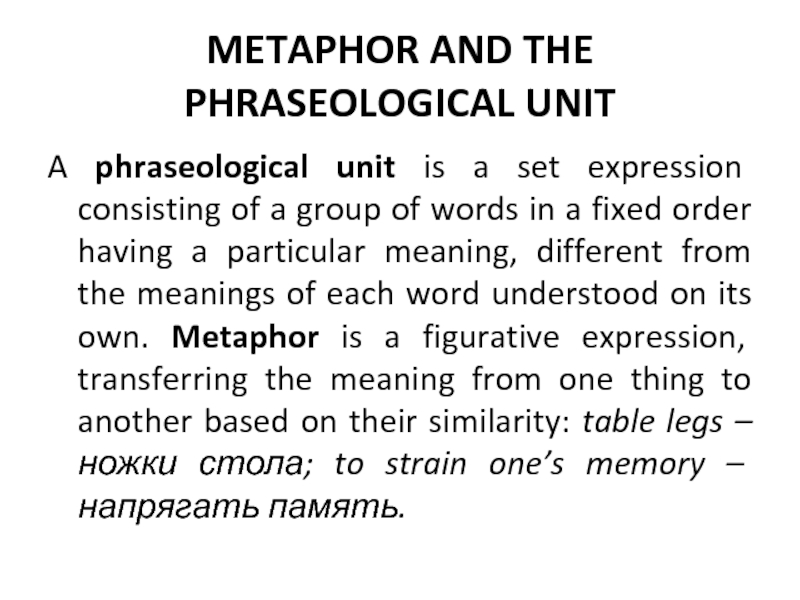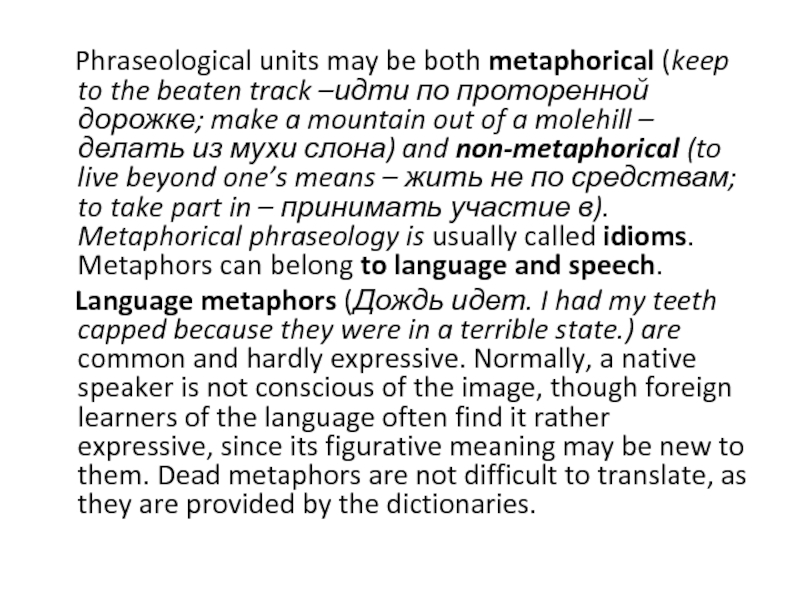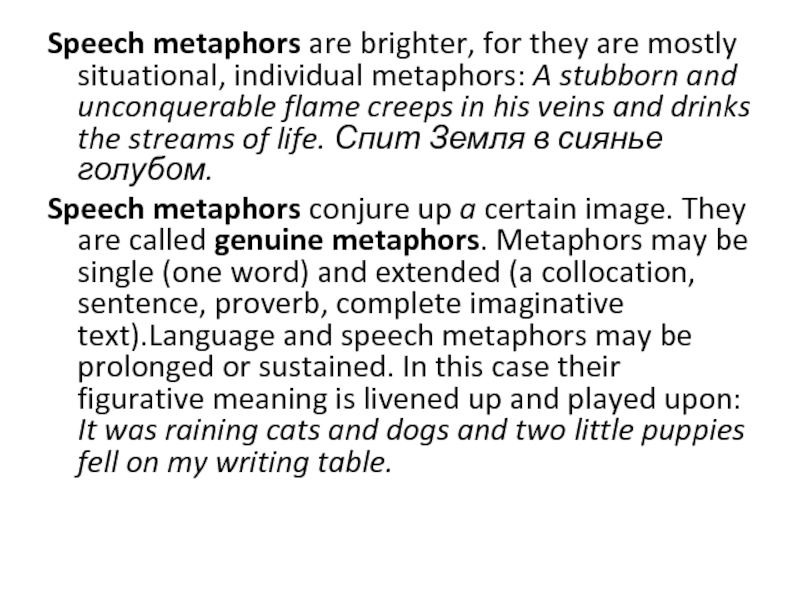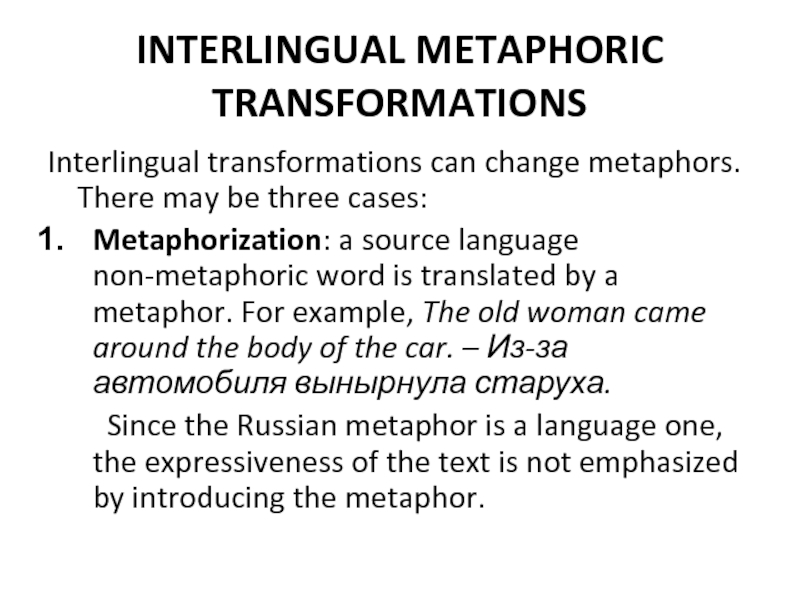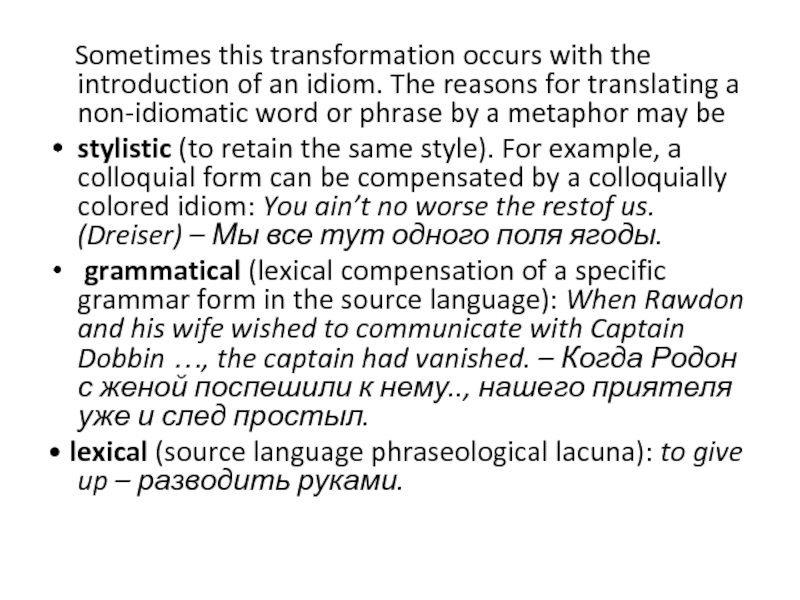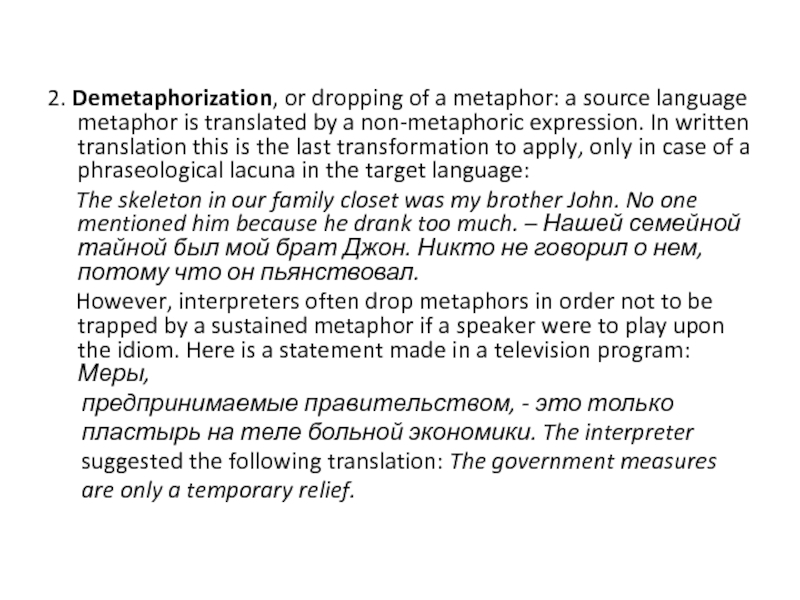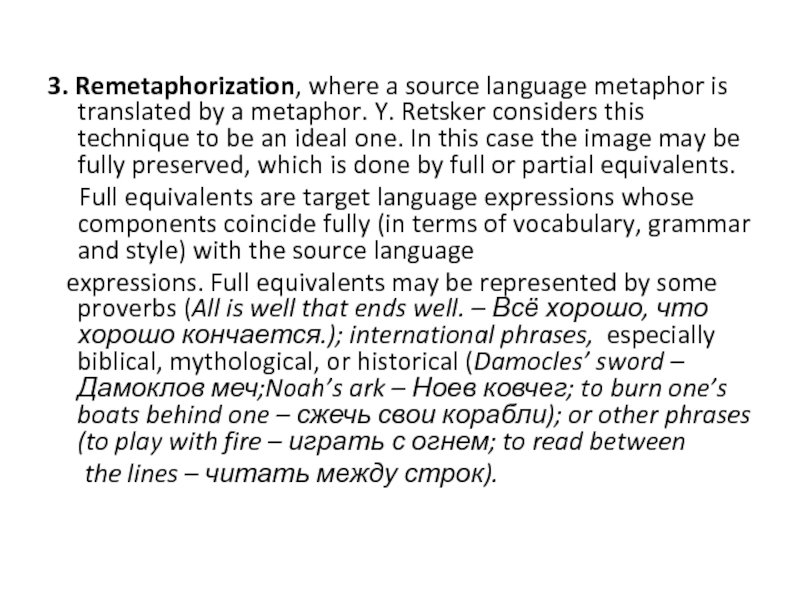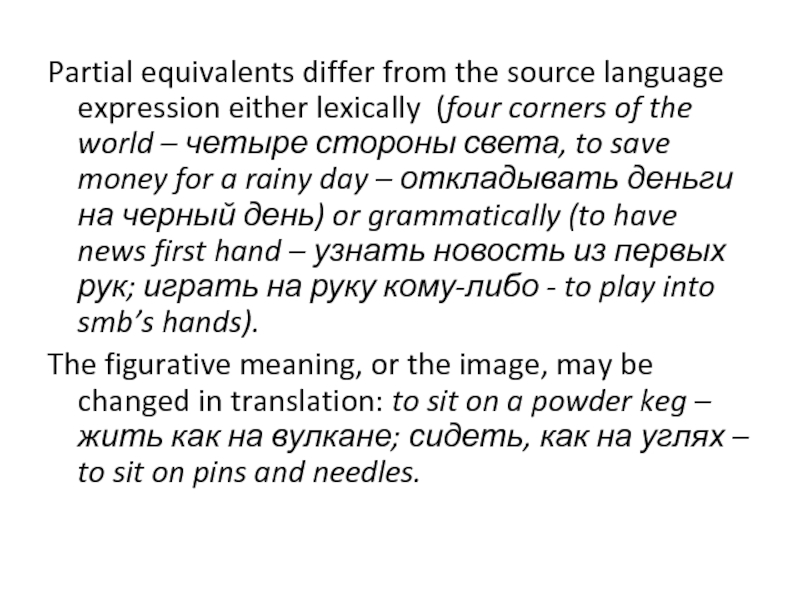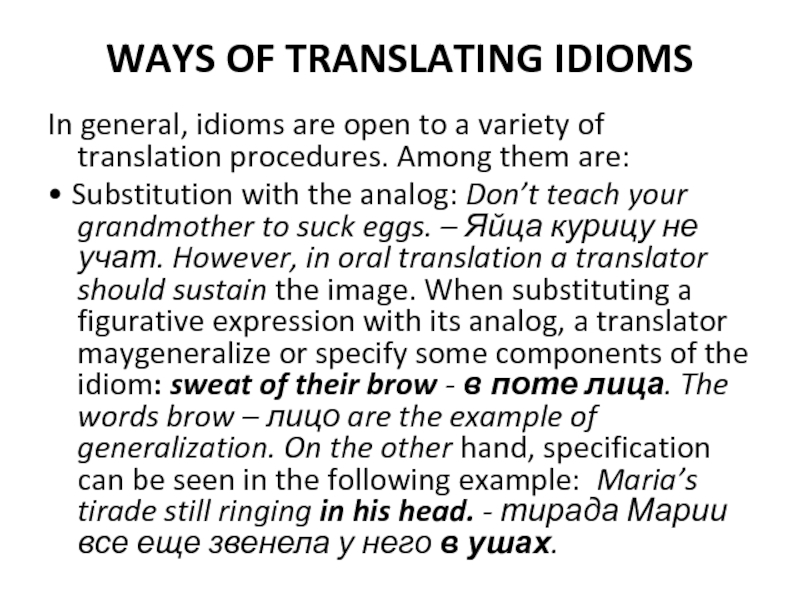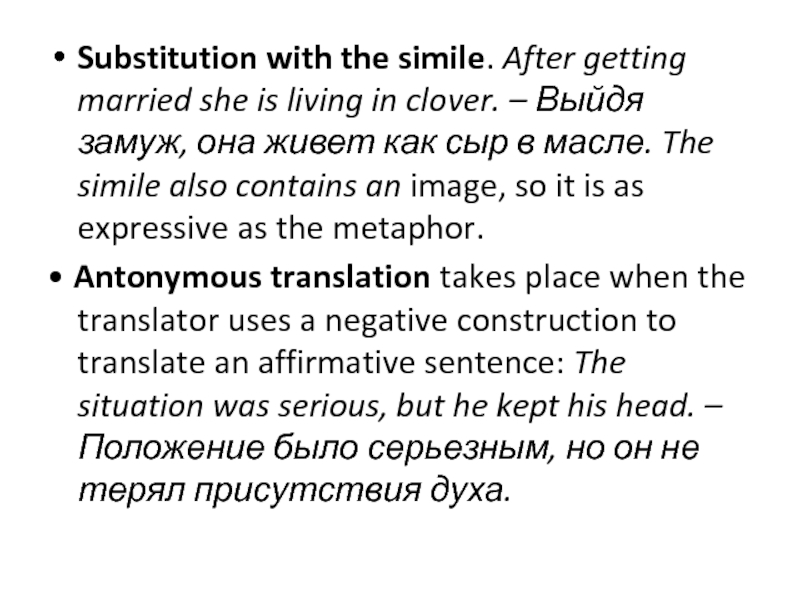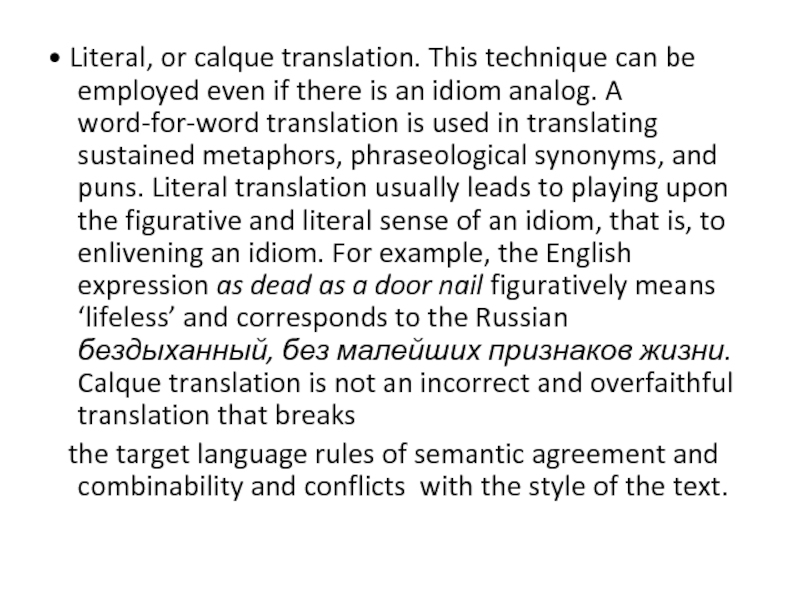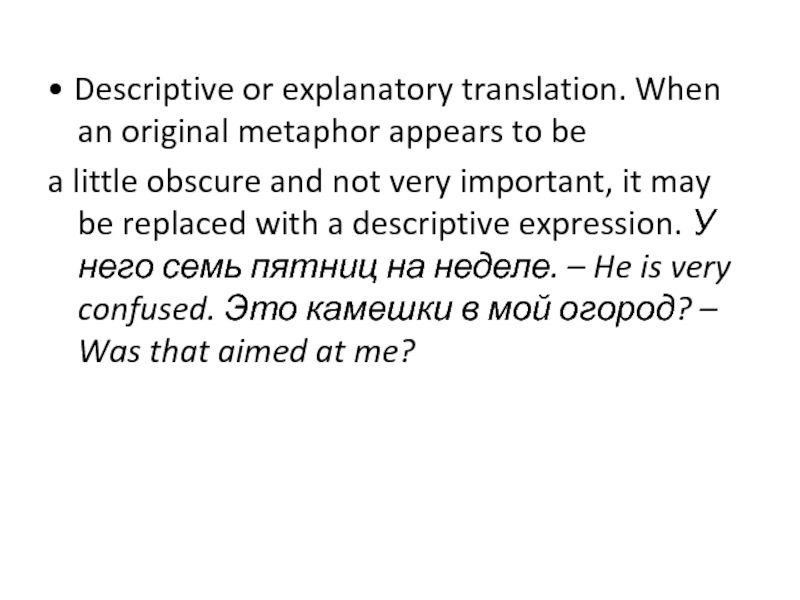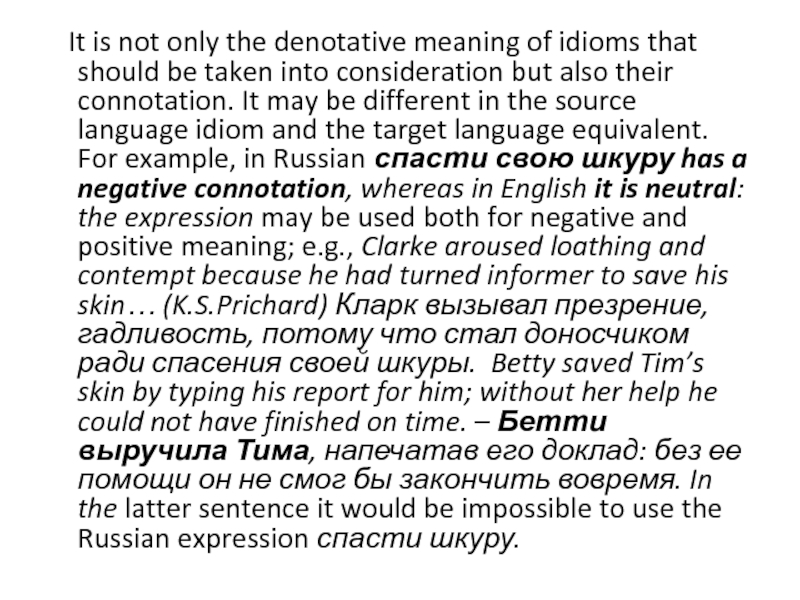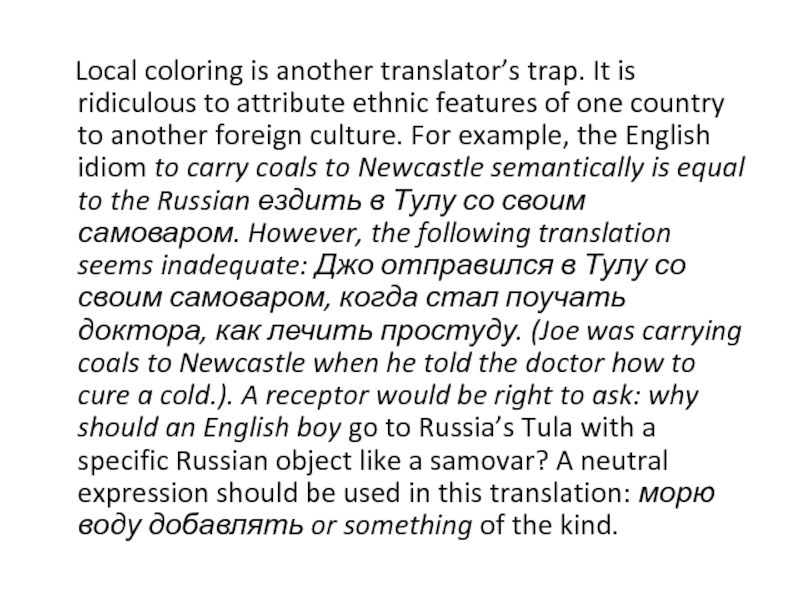- Главная
- Разное
- Дизайн
- Бизнес и предпринимательство
- Аналитика
- Образование
- Развлечения
- Красота и здоровье
- Финансы
- Государство
- Путешествия
- Спорт
- Недвижимость
- Армия
- Графика
- Культурология
- Еда и кулинария
- Лингвистика
- Английский язык
- Астрономия
- Алгебра
- Биология
- География
- Детские презентации
- Информатика
- История
- Литература
- Маркетинг
- Математика
- Медицина
- Менеджмент
- Музыка
- МХК
- Немецкий язык
- ОБЖ
- Обществознание
- Окружающий мир
- Педагогика
- Русский язык
- Технология
- Физика
- Философия
- Химия
- Шаблоны, картинки для презентаций
- Экология
- Экономика
- Юриспруденция
Phraseological and metaphorical translation презентация
Содержание
- 1. Phraseological and metaphorical translation
- 2. METAPHOR AND THE PHRASEOLOGICAL UNIT
- 3. Phraseological units may be both
- 4. Speech metaphors are brighter, for they are
- 5. INTERLINGUAL METAPHORIC TRANSFORMATIONS Interlingual transformations
- 6. Sometimes this transformation occurs with
- 7. 2. Demetaphorization, or dropping of
- 8. 3. Remetaphorization, where a source language
- 9. Partial equivalents differ from the source language
- 10. WAYS OF TRANSLATING IDIOMS In
- 11. Substitution with the simile. After getting married
- 12. • Literal, or calque translation. This technique
- 13. • Descriptive or explanatory translation. When an
- 14. CHALLENGES IN TRANSLATING IDIOMS
- 15. Variable equivalents, or synonymous
- 16. Another problem is translator’s ‘false friends’. When
- 17. It is not only the
- 18. Local coloring is another translator’s
Слайд 2
METAPHOR AND THE PHRASEOLOGICAL UNIT
A phraseological unit is a set expression
consisting of a group of words in a fixed order having a particular meaning, different from the meanings of each word understood on its own. Metaphor is a figurative expression, transferring the meaning from one thing to another based on their similarity: table legs –ножки стола; to strain one’s memory – напрягать память.
Слайд 3 Phraseological units may be both metaphorical (keep to the
beaten track –идти по проторенной дорожке; make a mountain out of a molehill – делать из мухи слона) and non-metaphorical (to live beyond one’s means – жить не по средствам; to take part in – принимать участие в). Metaphorical phraseology is usually called idioms. Metaphors can belong to language and speech.
Language metaphors (Дождь идет. I had my teeth capped because they were in a terrible state.) are common and hardly expressive. Normally, a native speaker is not conscious of the image, though foreign learners of the language often find it rather expressive, since its figurative meaning may be new to them. Dead metaphors are not difficult to translate, as they are provided by the dictionaries.
Language metaphors (Дождь идет. I had my teeth capped because they were in a terrible state.) are common and hardly expressive. Normally, a native speaker is not conscious of the image, though foreign learners of the language often find it rather expressive, since its figurative meaning may be new to them. Dead metaphors are not difficult to translate, as they are provided by the dictionaries.
Слайд 4Speech metaphors are brighter, for they are mostly situational, individual metaphors:
A stubborn and unconquerable flame creeps in his veins and drinks the streams of life. Спит Земля в сиянье голубом.
Speech metaphors conjure up a certain image. They are called genuine metaphors. Metaphors may be single (one word) and extended (a collocation, sentence, proverb, complete imaginative text).Language and speech metaphors may be prolonged or sustained. In this case their figurative meaning is livened up and played upon: It was raining cats and dogs and two little puppies fell on my writing table.
Speech metaphors conjure up a certain image. They are called genuine metaphors. Metaphors may be single (one word) and extended (a collocation, sentence, proverb, complete imaginative text).Language and speech metaphors may be prolonged or sustained. In this case their figurative meaning is livened up and played upon: It was raining cats and dogs and two little puppies fell on my writing table.
Слайд 5
INTERLINGUAL METAPHORIC TRANSFORMATIONS
Interlingual transformations can change metaphors. There may be three
cases:
Metaphorization: a source language non-metaphoric word is translated by a metaphor. For example, The old woman came around the body of the car. – Из-за автомобиля вынырнула старуха.
Since the Russian metaphor is a language one, the expressiveness of the text is not emphasized by introducing the metaphor.
Metaphorization: a source language non-metaphoric word is translated by a metaphor. For example, The old woman came around the body of the car. – Из-за автомобиля вынырнула старуха.
Since the Russian metaphor is a language one, the expressiveness of the text is not emphasized by introducing the metaphor.
Слайд 6 Sometimes this transformation occurs with the introduction of an
idiom. The reasons for translating a non-idiomatic word or phrase by a metaphor may be
stylistic (to retain the same style). For example, a colloquial form can be compensated by a colloquially colored idiom: You ain’t no worse the restof us. (Dreiser) – Мы все тут одного поля ягоды.
grammatical (lexical compensation of a specific grammar form in the source language): When Rawdon and his wife wished to communicate with Captain Dobbin …, the captain had vanished. – Когда Родон с женой поспешили к нему.., нашего приятеля уже и след простыл.
• lexical (source language phraseological lacuna): to give up – разводить руками.
stylistic (to retain the same style). For example, a colloquial form can be compensated by a colloquially colored idiom: You ain’t no worse the restof us. (Dreiser) – Мы все тут одного поля ягоды.
grammatical (lexical compensation of a specific grammar form in the source language): When Rawdon and his wife wished to communicate with Captain Dobbin …, the captain had vanished. – Когда Родон с женой поспешили к нему.., нашего приятеля уже и след простыл.
• lexical (source language phraseological lacuna): to give up – разводить руками.
Слайд 7
2. Demetaphorization, or dropping of a metaphor: a source language metaphor
is translated by a non-metaphoric expression. In written translation this is the last transformation to apply, only in case of a phraseological lacuna in the target language:
The skeleton in our family closet was my brother John. No one mentioned him because he drank too much. – Нашей семейной тайной был мой брат Джон. Никто не говорил о нем, потому что он пьянствовал.
However, interpreters often drop metaphors in order not to be trapped by a sustained metaphor if a speaker were to play upon the idiom. Here is a statement made in a television program: Меры,
предпринимаемые правительством, - это только
пластырь на теле больной экономики. The interpreter
suggested the following translation: The government measures
are only a temporary relief.
The skeleton in our family closet was my brother John. No one mentioned him because he drank too much. – Нашей семейной тайной был мой брат Джон. Никто не говорил о нем, потому что он пьянствовал.
However, interpreters often drop metaphors in order not to be trapped by a sustained metaphor if a speaker were to play upon the idiom. Here is a statement made in a television program: Меры,
предпринимаемые правительством, - это только
пластырь на теле больной экономики. The interpreter
suggested the following translation: The government measures
are only a temporary relief.
Слайд 8
3. Remetaphorization, where a source language metaphor is translated by a
metaphor. Y. Retsker considers this technique to be an ideal one. In this case the image may be fully preserved, which is done by full or partial equivalents.
Full equivalents are target language expressions whose components coincide fully (in terms of vocabulary, grammar and style) with the source language
expressions. Full equivalents may be represented by some proverbs (All is well that ends well. – Всё хорошо, что хорошо кончается.); international phrases, especially biblical, mythological, or historical (Damocles’ sword – Дамоклов меч;Noah’s ark – Ноев ковчег; to burn one’s boats behind one – сжечь свои корабли); or other phrases (to play with fire – играть с огнем; to read between
the lines – читать между строк).
Full equivalents are target language expressions whose components coincide fully (in terms of vocabulary, grammar and style) with the source language
expressions. Full equivalents may be represented by some proverbs (All is well that ends well. – Всё хорошо, что хорошо кончается.); international phrases, especially biblical, mythological, or historical (Damocles’ sword – Дамоклов меч;Noah’s ark – Ноев ковчег; to burn one’s boats behind one – сжечь свои корабли); or other phrases (to play with fire – играть с огнем; to read between
the lines – читать между строк).
Слайд 9Partial equivalents differ from the source language expression either lexically (four
corners of the world – четыре стороны света, to save money for a rainy day – откладывать деньги на черный день) or grammatically (to have news first hand – узнать новость из первых рук; играть на руку кому-либо - to play into smb’s hands).
The figurative meaning, or the image, may be changed in translation: to sit on a powder keg – жить как на вулкане; сидеть, как на углях – to sit on pins and needles.
The figurative meaning, or the image, may be changed in translation: to sit on a powder keg – жить как на вулкане; сидеть, как на углях – to sit on pins and needles.
Слайд 10
WAYS OF TRANSLATING IDIOMS
In general, idioms are open to a variety
of translation procedures. Among them are:
• Substitution with the analog: Don’t teach your grandmother to suck eggs. – Яйца курицу не учат. However, in oral translation a translator should sustain the image. When substituting a figurative expression with its analog, a translator maygeneralize or specify some components of the idiom: sweat of their brow - в поте лица. The words brow – лицо are the example of generalization. On the other hand, specification can be seen in the following example: Maria’s tirade still ringing in his head. - тирада Марии все еще звенела у него в ушах.
• Substitution with the analog: Don’t teach your grandmother to suck eggs. – Яйца курицу не учат. However, in oral translation a translator should sustain the image. When substituting a figurative expression with its analog, a translator maygeneralize or specify some components of the idiom: sweat of their brow - в поте лица. The words brow – лицо are the example of generalization. On the other hand, specification can be seen in the following example: Maria’s tirade still ringing in his head. - тирада Марии все еще звенела у него в ушах.
Слайд 11Substitution with the simile. After getting married she is living in
clover. – Выйдя замуж, она живет как сыр в масле. The simile also contains an image, so it is as expressive as the metaphor.
• Antonymous translation takes place when the translator uses a negative construction to translate an affirmative sentence: The situation was serious, but he kept his head. – Положение было серьезным, но он не терял присутствия духа.
• Antonymous translation takes place when the translator uses a negative construction to translate an affirmative sentence: The situation was serious, but he kept his head. – Положение было серьезным, но он не терял присутствия духа.
Слайд 12• Literal, or calque translation. This technique can be employed even
if there is an idiom analog. A word-for-word translation is used in translating sustained metaphors, phraseological synonyms, and puns. Literal translation usually leads to playing upon the figurative and literal sense of an idiom, that is, to enlivening an idiom. For example, the English expression as dead as a door nail figuratively means ‘lifeless’ and corresponds to the Russian бездыханный, без малейших признаков жизни. Calque translation is not an incorrect and overfaithful translation that breaks
the target language rules of semantic agreement and combinability and conflicts with the style of the text.
the target language rules of semantic agreement and combinability and conflicts with the style of the text.
Слайд 13• Descriptive or explanatory translation. When an original metaphor appears to
be
a little obscure and not very important, it may be replaced with a descriptive expression. У него семь пятниц на неделе. – He is very confused. Это камешки в мой огород? – Was that aimed at me?
a little obscure and not very important, it may be replaced with a descriptive expression. У него семь пятниц на неделе. – He is very confused. Это камешки в мой огород? – Was that aimed at me?
Слайд 14
CHALLENGES IN TRANSLATING IDIOMS
One of the difficulties a translator
encounters is selecting a variable equivalent. It should be as expressive as the original and correspond in style and connotation, and convey an adequate meaning. For example, the idiom to pull one’s leg has the following equivalents: обманывать, разыгрывать кого-то, морочить голову, водить за нос. In the dialog “You are pulling my leg.” “ I’m not pulling your leg; nothing would induce me to touch your beastly leg.” (P. D. Wodehouse), this expression can be translated by морочить голову because it best suits the situation: «Ты морочишь мне голову.» «Я не морочу тебе голову; ничто не заставит меня даже прикоснуться к твоей дурацкой голове.»
Слайд 15 Variable equivalents, or synonymous idioms, used in one
and the same text, break the monotony of the text and help to diversify the style. For example, in one of his works J. Galsworthy used the expression to cost a pretty money several times. To avoid monotony in the translated text, the translator applied variable equivalents: She cost him a pretty money in dress. – Ее туалеты, должно быть, недешево ему обходятся. She was spending a pretty penny on dress. – Она тратит уйму денег на наряды. When choosing an equivalent, a translator should observe the requirements of proper style. For example, the proverb Can the leopard change its spots? corresponds to some Russian equivalents – Может ли человек изменить свою судьбу? (neutral explanatory equivalent), Горбатого могила исправит. (informal expression), Черного кобеля не отмоешь добела. (low colloquial). The selection
of an adequate equivalent will depend on the text style.
of an adequate equivalent will depend on the text style.
Слайд 16Another problem is translator’s ‘false friends’. When calqued, idioms may have
another, even opposite, meaning as compared with the original one. For example, to pour oil on troubled waters does not correspond to the Russian подливать масла в огонь, whose meaning is 'to add fuel to the flame'. On the contrary, the expression means утихомиривать, успокаивать (to calm).
Similarly, to see eye to eye with somebody – сходиться во взглядах, to run somebody to the ground– достать из-под земли, to wash one’s neck – закладывать за галстук, пьянствовать.
Similarly, to see eye to eye with somebody – сходиться во взглядах, to run somebody to the ground– достать из-под земли, to wash one’s neck – закладывать за галстук, пьянствовать.
Слайд 17 It is not only the denotative meaning of idioms
that should be taken into consideration but also their connotation. It may be different in the source language idiom and the target language equivalent. For example, in Russian спасти свою шкуру has a negative connotation, whereas in English it is neutral: the expression may be used both for negative and positive meaning; e.g., Clarke aroused loathing and contempt because he had turned informer to save his skin… (K.S.Prichard) Кларк вызывал презрение, гадливость, потому что стал доносчиком ради спасения своей шкуры. Betty saved Tim’s skin by typing his report for him; without her help he could not have finished on time. – Бетти выручила Тима, напечатав его доклад: без ее помощи он не смог бы закончить вовремя. In the latter sentence it would be impossible to use the Russian expression спасти шкуру.
Слайд 18 Local coloring is another translator’s trap. It is ridiculous
to attribute ethnic features of one country to another foreign culture. For example, the English idiom to carry coals to Newcastle semantically is equal to the Russian ездить в Тулу со своим самоваром. However, the following translation seems inadequate: Джо отправился в Тулу со своим самоваром, когда стал поучать доктора, как лечить простуду. (Joe was carrying coals to Newcastle when he told the doctor how to cure a cold.). A receptor would be right to ask: why should an English boy go to Russia’s Tula with a specific Russian object like a samovar? A neutral expression should be used in this translation: морю воду добавлять or something of the kind.
